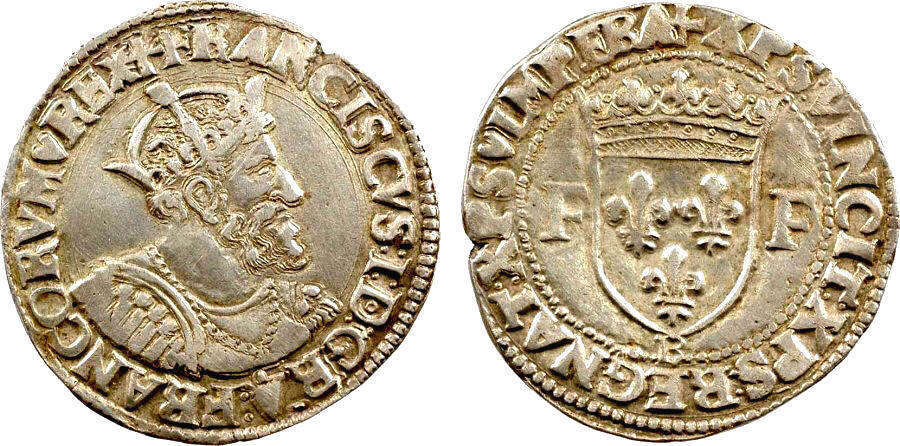
Francis I. Teston.
Whether the reign of Henry II should be considered the beginning of the end of the Valois dynasty is a controversial and, by and large, not very important question. What is certain is that it was at this time that relations between the Huguenots (the French name for Calvinists) and Catholics became extremely tense, and the king played a significant role in this aggravation. As a result, all 42 years, which included the reign of four kings (Henry himself and his three sons), were marked by this confrontation, in a civil war that sometimes died down and sometimes resumed, and the last king of the Valois family fell victim to this struggle.
By the way, the previous French royal dynasty (the Capetians) came to an end after three sons of Philip the Fair successively ascended the throne. A strange coincidence... However, French writers (Druon and Dumas, respectively) have already had their fill of frolicking in this field. :) In no way do I want to say anything bad about their books, on the contrary, I like them very much. Of course, both of them somewhat exaggerated the number of violent deaths, but it was hard to resist here. :)
Francis succeeded the childless Louis XII on the throne, to whom he was a cousin and also a son-in-law.

Francis I. Teston.
It was the time of the Renaissance, the king was known as a patron of the arts, and perhaps that is why Francis was so drawn to Italy. True, this attraction manifested itself in an unusual way - throughout his reign he fought there (mostly quite successfully) with the Holy Roman Emperor Maximilian, and then his successor Charles V.
In a series of wars, the Battle of Pavia in 1525 stands out, where Francis was wounded, captured and forced to give in to all the demands of his opponents. The king's eldest sons, Francis and Henry, who were sent to Madrid, became hostages guaranteeing the fulfillment of his obligations. Their father was apparently not very concerned about this, since he tore up the peace treaty six months later.
In passing, let us turn our attention to Emperor Charles V, who, despite Francis's outright betrayal of his own word (at a time when the knightly code of honor was still remembered, this was a very serious offense), released the hostages unharmed three years later.
The feud with the emperor was inherited by
his son Henry II, who ascended the throne on March 31, 1547 (his elder brother had died in 1536).
It must be said that all these continuous wars, in the end, brought the state only Calais, Metz and a huge budget deficit, and almost all possessions outside France were lost.
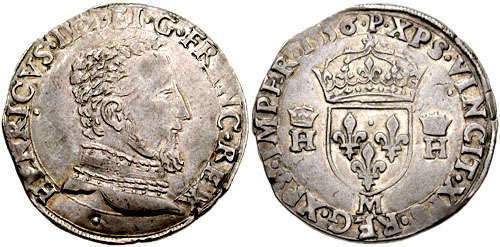
Henry II. Teston 1556
The main actors in the battles were the Constable de Montmorency and Duke Francois de Guise. They fought for influence over the king. It was from this time that the rise of the Guises, a junior branch of the House of Lorraine, began. Although they were called dukes, they did not have nominally independent possessions (which is why they did not mint coins).
As for military affairs, the most memorable for the constable was probably his capture after the defeat at Saint-Quentin, while Guise took the last stronghold of the English on the continent - Calais. It is not that Montmorency lost all the battles, and Guise always won, but these events clearly affected their popularity. The influence of the Guises increased even more when, in 1558, the heir to the French royal throne Francis married the heir to the Scottish crown, Mary Stuart (daughter of Mary of Guise and King of Scotland James V).
In the area of religion, Henry adhered to the policy of his father, who did not recognize compromises in the last years of his reign and persecuted the Huguenots.
Now it is difficult to say to what extent the king personally influenced the policy of the state. Most researchers agree that he was not very interested in this and generally consider him a narrow-minded warrior. And he did not pay attention to art, unlike his father. However, let's not forget that the future King Henry spent his best childhood years from the age of seven to ten in various Spanish prisons, which hardly contributed to the formation of a cheerful and well-rounded personality.
The king loved knightly entertainment and chivalry in general, as a way of life. Perhaps this was a kind of response to the not very knightly behavior of his father, during Henry's Spanish captivityha, because in fact in the 16th century all these multi-day tournaments and courtesies with the enemy in war were already a thing of the past. But the king organized tournaments, moreover, he himself participated in them. In 1559, at one of these tournaments, part of a spear shaft, split by a blow to the armor, pierced Henry II's eye and he died a few days later. With the death of the last knight king, the era of chivalry ended, and the period of religious wars began.
The king's widow Catherine de Medici, who had previously been in the shadow of Henry II's mistress Diane de Poitiers, came to the fore. Now the queen became regent for Francis II, who, although formally an adult (in 1559 he was 16 years old), could not and did not want to deal with state affairs, due to his youth and illness.
François de Guise and his younger brother Charles, naturally did not stand aside either, since they were uncles of the king's wife, whom he adored. The opposing party was led by Antoine de Bourbon (husband of the Queen of Navarre Jeanne d'Albret), his brother Louis de Condé and nephew of the Constable de Montmorency Gaspard de Coligny. Since the Guises were zealous Catholics, their opponents had to become Huguenots. :) In 1560, this trio organized the Amboise conspiracy. It was supposed to capture the king, force him to remove the Guises and stop the persecution of Protestants. The plot was uncovered, the ringleaders were captured and escaped death only thanks to the intercession of Catherine de Medici.
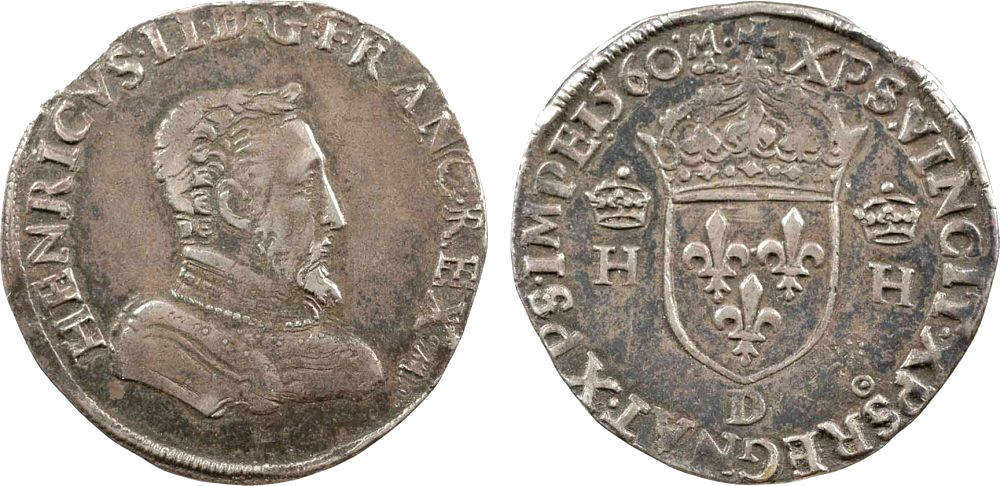
Francis II. Teston 1560 with a portrait and name of Henry II
At this time, after an illness due to an abscess in the ear and subsequent gangrene, the king died. During his reign, which lasted one and a half years, they did not even have time to mint coins with his portrait.
The next king, Charles IX, was 10 years old and, naturally, this change on the throne did not particularly affect anything. Catherine remained regent, the Catholics continued to persecute the Protestants, who defended themselves and, gradually, these clashes escalated into a real war, with battles and sieges of cities. During one of these sieges, at Orleans, François de Guise was shot in the back and killed (1563).
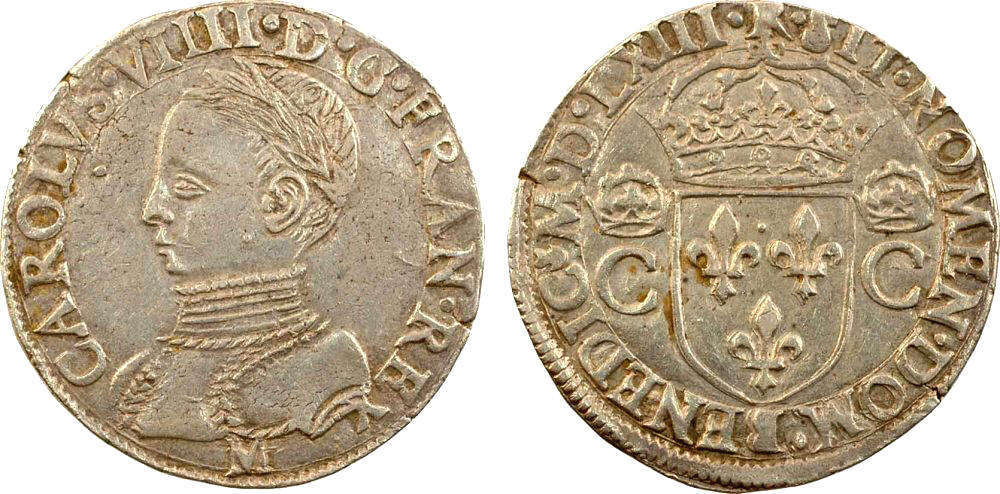
Charles IX. Teston 1563
In the same year of 1563, Charles IX came of age (at that time, this happened at the age of 14) and Catherine de Medici formally resigned her powers as regent. However, before that, in 1562, through the efforts of Catherine and Chancellor L'Hôpital, the Edict of Toleration was adopted.
In 1565, the Queen Mother organized a grand tour of the country for the King (the delegation included, in addition to Charles, his brothers Henry and François, as well as Henry of Navarre), with the goal of showing the royal family to the people and at least somehow pacifying the warring parties. This partly succeeded, but not for long. In 1567, the Protestants again tried to kidnap the King and again they failed.
In 1570, Charles, who was already 20 years old, married Elizabeth, the daughter of Emperor Maximilian II.
He still did not deal with state affairs, leaving them to his mother. Charles's main passions were hunting and literature, which were combined in a book about hunting written by the king.
In 1572, the king's sister Margaret married Henry de Bourbon, who had by then become king of Navarre (which, however, did not free him from the position of a prisoner at court). It was assumed that this would reconcile Catholics with Protestants, since Henry was considered one of the leaders of the Huguenots. Whether he considered himself as such is a big question - it would be more accurate to say that he inherited this title from his mother.
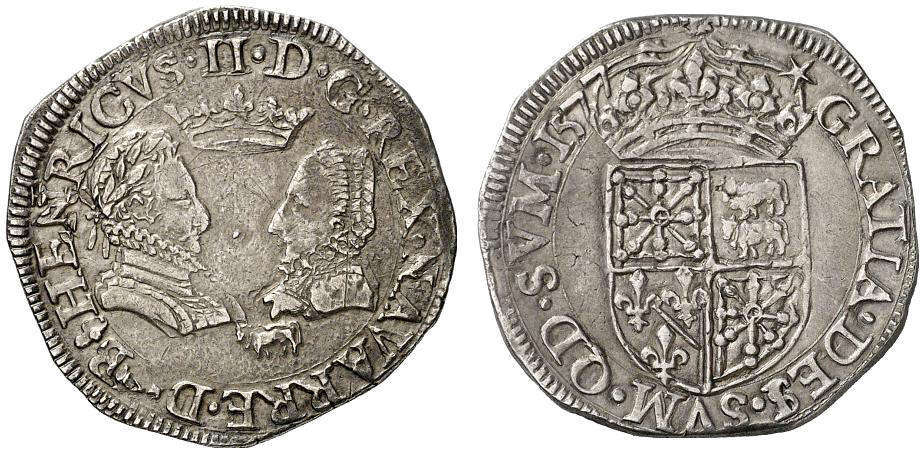
Henry of Navarre and Margaret of Valois. Teston of the Viscountcy of Béarn 1577
Four days after the wedding, one of the Huguenot leaders, Admiral Coligny, was wounded by a musket shot. Charles, who was so kind to the admiral that he even called him father (it is not known whether sincerely or feignedly), personally visited Coligny and promised to find the assailant.
On August 23, 1573, a meeting of citizens in the town hall decided to take revenge on the Huguenots for everything they had done against the true religion and, without delaying in the matter for a long time,box, set out to carry out their plan. The infamous St. Bartholomew's Day massacre began. More than two thousand people were killed, including the wounded Coligny and many noble Protestants who had come to the wedding. It is clear that this massacre was being prepared by someone and one of its instigators is known for sure - Henry of Guise, driven by revenge for the death of his father.
But the extent to which the royal family participated in this is unknown. It is difficult to imagine that Catherine de Medici and the king knew nothing at all, but there is no direct evidence of their guilt. The stories that Charles fired from the Louvre window at the fleeing Huguenots are not confirmed by anything. But there is evidence that the royal council took Henry of Navarre and the Prince of Conde under its protection. On the other hand, the Parisian mob slaughtered the Huguenots with the king's name on their lips, and after the St. Bartholomew's Day massacre, government manifestos were distributed stating that the Protestants were being punished for the rebellion they had been preparing.
One way or another, these events did not change anything in particular, except that the civil war continued with even greater ferocity.
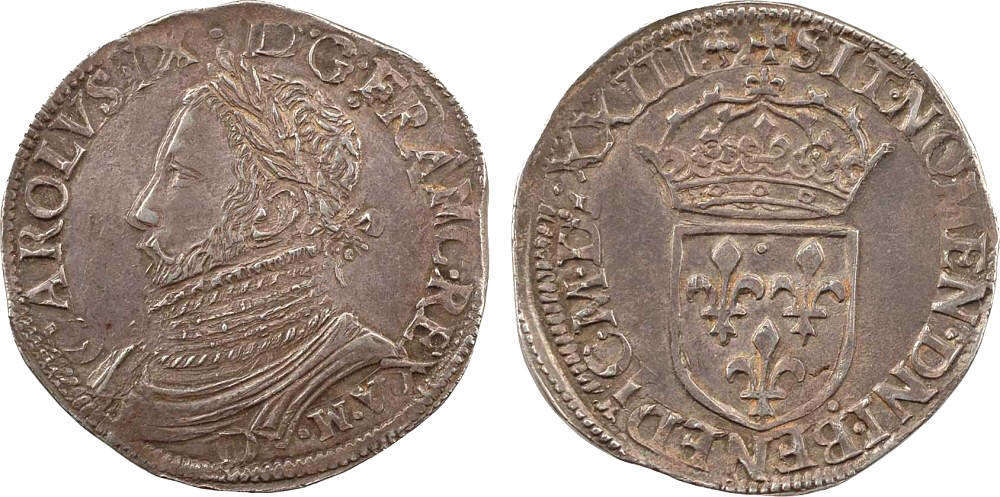
Charles IX. Teston 1573
A year later, Charles IX, who was not known for his heroic health, died of pleurisy complicated by tuberculosis. The story of the poisoned book, masterfully told by Dumas, is also not confirmed by anything.
The penultimate son of Henry II, Henry III, ascended the throne. Unlike his predecessor brothers, the 23-year-old king was already a fully formed personality and, in general, an extraordinary personality. Most historians agree that only the extremely difficult situation of the state prevented him from becoming one of the best rulers of the kingdom. Henry was easily taught science and art, as well as physical exercises and military affairs. He did not get along well with his brothers, who were jealous of his mother, who clearly preferred Henry.
Catherine managed to instill in her favorite the ideas of religious tolerance, which, however, neither she nor he managed to implement - too many extremist-minded individuals from both warring parties were interested in inciting discord.
In 1566, Henry received the title of Duke of Anjou and several large estates, which gave him financial independence.
He led the army in several major battles with the Huguenots, first formally, and then as a real commander.
In 1573, during the siege of Protestant La Rochelle, Henry learned that he had been elected King of Poland. Negotiations with the Poles had been underway for about a year, but the image of the French prince was seriously damaged by the massacre on St. Bartholomew's Day. Nevertheless, the struggle at the Sejm between the supporters of the Habsburgs and their opponents led to the election of a Frenchman as a compromise option.
Incidentally, one of the contenders for the Polish throne (more nominal, after all) was Ivan the Terrible.
Henry was not eager to go to Poland. King Charles's health did not inspire optimism, and since he had no male children, it would be better for the direct heir to be closer to Paris. But there was nothing to be done, and the prince's huge caravan slowly moved towards Krakow. The meeting of the new Polish king took place on February 18, 1574 and made an indelible impression on
all those present. The stern Polish lords looked with dismay at the young man hung with feathers and rings, smelling of perfume, and Henry, in turn, was surprised by the not very sober nobles dressed in furs. In short, the new king had practically nothing in common with his new people.
It is clear that Henry did not even try to deal with the state affairs of a country that he did not understand, and no one expected this from him - they had not invited him for that.
On June 15, a letter arrived informing him of the death of Charles IX, and four days later Henry secretly left Poland. The Sejm decided that if the king did not return by May 1575, he would lose the Polish throne. Henry, naturally, did not return, but for those one and a half years he was listed as the king of Poland
under the name of Henryk Walesa. It is a pity that Polish coins with his name were not minted. :(
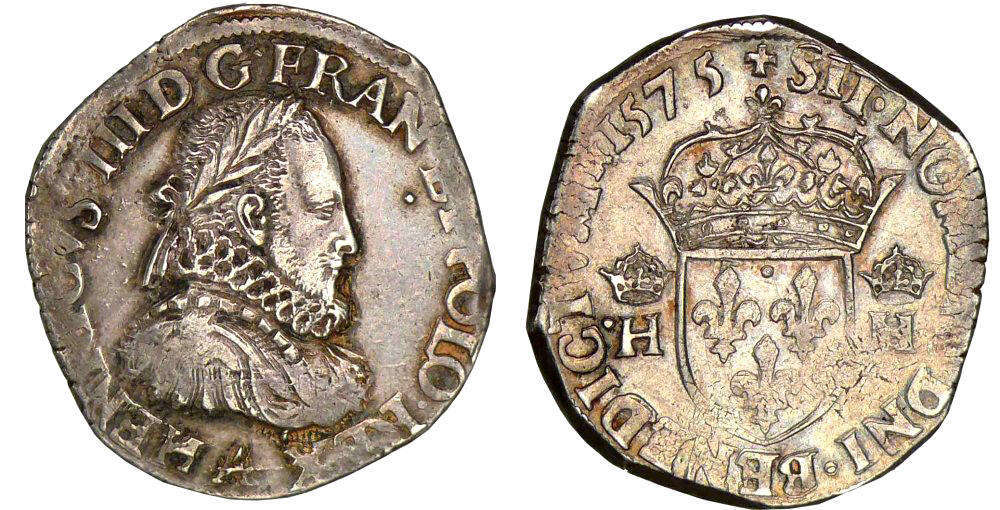
Henry III King of France and Poland. Teston 1575
In France, meanwhile, things were getting worse and worse. Henry III was forced to give Protestants the opportunity to be elected to local parliaments, as a result of which some cities with a predominantly Huguenot population found themselves practically independent. This caused oppositionrecently created (1576) by the Guise brothers of the Catholic League. The war broke out with renewed vigor.
On the one hand, the Guises, trying to find a king more convenient for themselves, on the other hand, the younger brother François, did not let Henry forget that he needed an heir.
By the way, the version about the non-traditional sexual orientation of the king also remains only a version, not confirmed by anything.
In 1572, Henry fell in love with Marie of Cleves, the niece of Jeanne of Navarre, which would not have been surprising (by all accounts, she was distinguished by her beauty), if he had not immediately decided to marry her. But the queen mother, true to her policy of reconciliation through matrimonial ties, intended this girl as a wife for the Prince of Condé, and Henry had to give in. In 1574, Mary died in childbirth, and this event plunged Henry into such a deep depression that it struck the court, which was not used to burdening itself with strong feelings and attachments.
In 1575, the king married Louise de Waudsmont, a modest girl from the provinces, who belonged to the younger branch of the House of Lorraine. Here Henry acted against the will of his mother, who had prepared a completely different candidate for him. The marriage was childless, due to Louise's health problems. The king, under the influence of circumstances, turned to religion, but numerous pilgrimages and vows did not help (by the way, one of the vows was to refuse relations with other women).
Hopes for the appearance of an heir melted away with each passing day. In 1584, the king's younger brother, François of Anjou, died and his closest relative turned out to be his childhood confidant and now the head of the Huguenots, Henry of Navarre. In 1585, the Guises, worried about the developments, initiated a new conflict, called the War of the Three Henrys (Henry of Guise, Henry of Navarre and Henry III), with the Guises fighting mainly with the King of Navarre, while the King of France tried to maneuver between them and achieve an end to the war.
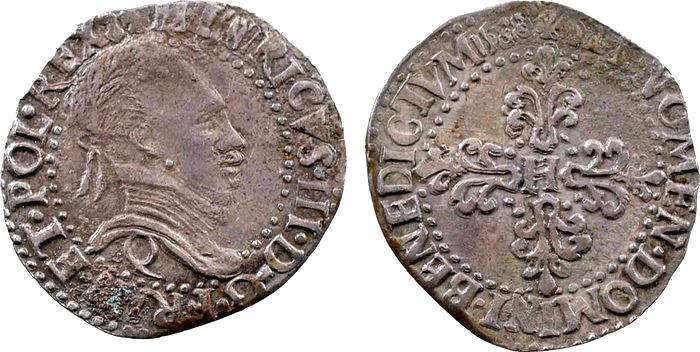
Henry III. 1/4 franc 1588
On May 12, 1588, Paris rebelled, Henry III was forced to flee, and Henry de Guise solemnly entered the capital. He already felt like a king and probably would have become one, if he had not been killed on December 23 by order of Henry III, who had been driven to despair. The next day, the younger Guise, Cardinal Louis of Lorraine, was killed. The next step of the king was an alliance with Henry of Navarre and a joint siege of Paris.
On July 31, 1589, Henry III was mortally wounded by the monk Jacques Clement, who had made his way to an audience with him, and died on August 2, cursed by both Catholics and Huguenots.
"What I love, I love to the end" - this phrase of the king perhaps best characterizes his reign. He took everything to extremes, be it religiosity, love for women, friends, jewelry or dogs. However, this did not prevent him from carrying out a number of important economic and administrative reforms, some of which were personally authored by Henry. It is a pity that there was time for this only in the short intervals between wars.
Henry III was buried not in Saint-Denis, but in Compiegne, since someone prophesied to Henry of Navarre that he himself would lie in the royal tomb a week after his predecessor.
Two years later, Henry III was remembered by his irreconcilable opponents from the Catholic League. Pressed by Henry of Navarre, now King Henry IV, they tried to find their own king to counter him, instead of the deceased Cardinal Charles de Bourbon, whom the League considered King Charles X. The search was unsuccessful and it was decided to consider Henry III as king.
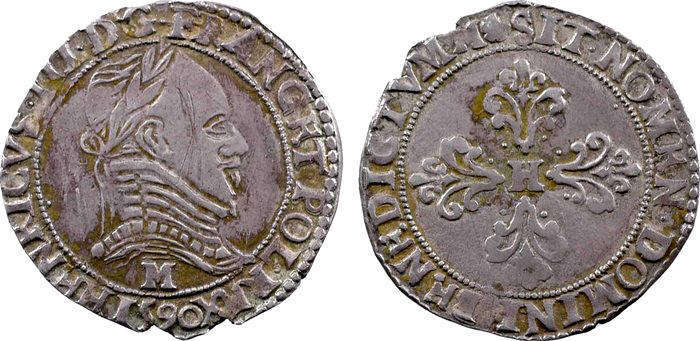
League. 1/2 franc 1590
In 1610, Henry IV finally decided to move the remains of the last Valois to Saint-Denis. A week passed, nothing happened. The king sighed with relief. He was killed a few weeks later...
©2012